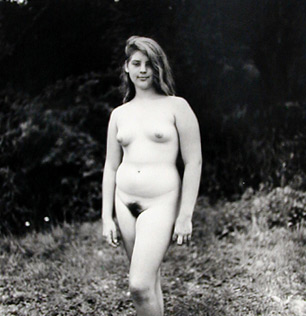Diane Arbus
(1923-1971)
A photograph is a secret about a secret. The more it tells you the less you know.
-Diane Arbus, ArtForum, May 1971
Diane Arbus believed that a camera could be “a little bit cold, a little bit harsh”, but that its scrutiny revealed the truth – the difference between what people wanted others to see and what they really did see.
Arbus started her career as a commercial photographer along with her then husband, Allan Arbus. In the 1940’s Diane’s father, owner of Russek’s, a famous 5th Avenue department store, employed them to take photographs for the department store’s advertisements. Their work concentrated primarily on fashion photography, and together they worked for many of the top publications of the time including Vogue and Harper’s Bazaar.
Their early interest in photography led them, in 1941, to visit the gallery of Alfred Stieglitz and learn about the photographers Mathew Brady, Timothy O’Sullivan, Paul Strand, Bill Brandt and Eugene Atget. In 1956 Arbus quit the commercial photography business, and although she studied photography with Berenice Abbott, her studies began with photographer Lisette Model. In 1963 Arbus was awarded a Guggenheim Fellowship for her project, American Rites, Manners, and Customs. The fellowship was renewed in 1966. It was during this project, in 1964 that Diane Arbus began using her signature square format, a twin-lens Mamiya reflex with flash in addition to a Rolleiflex.
During the 1960’s Diane Arbus taught at the Parson’s School of Design and Copper Union, in New York City, and the Rhode Island School of Design. The first major exhibition of her work occurred at the Museum of Modern Art in 1967, in the exhibition entitled, New Documents, alongside the works of Garry Winogrand and Lee Friendlander, curated by John Szarkowski. On July 26th, 1971 Diane Arbus took her own life.
In 1972 Diane Arbus was the first American photographer to have photographs displayed at the Venice Biennale. Her ten photographs were described as “an overwhelming sensation of the American Pavilion”. The Museum of Modern Art held a Retrospective of Arbus’ work in late 1972 and subsequently traveled it around the United States and Canada; it was estimated that over seven million people saw the exhibition. In 1972, one of her daughters, Doon Arbus and close friend, Marvin Israel, edited and designed a book entitled, Diane Arbus – An Aperture Monograph, to accompany the MoMA exhibition. It was also around that time that they engaged Diane’s printer, Neil Selkirk, to produce an edition of prints from a carefully select group of images.
